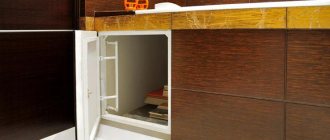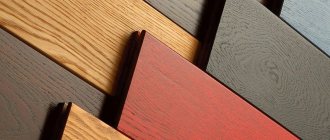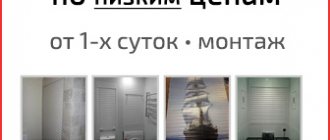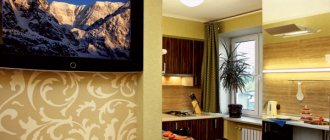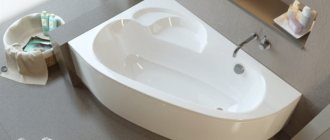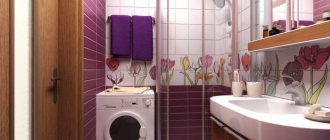The screen under the bathtub is a relatively simple but practical design.
Such a decorative product consists of several basic elements, most often represented by a frame, as well as panels and doors, sometimes shelves and drawers.
This design is quite easy to make yourself.
No. 1. What types of screens are there?
Depending on the design, all bath screens are divided into the following three types:
- sliding and hinged . This is one of the most practical and convenient options, because it allows you not only to hide communications, but also to use the space under the bathroom to your advantage, storing household chemicals or other things there;
- removable non-sliding screens are usually installed under acrylic bathtubs. They allow you to relatively quickly gain access to communications if something needs to be repaired, but the not-so-simple screen removal system does not allow you to store things that are constantly needed there;
- stationary screens look aesthetically pleasing, because the bathroom space is perceived as harmonious and monolithic, but this place cannot be used for storing things, which may seem irrational.
Price
In modern screen structures, the frame is made of a four-chamber PVC profile in accordance with patented technology, and due to the absence of a closed frame, installation of the product is easily carried out in places where the water supply system passes.
The average cost of such products is 1500-2500 rubles.
It is important to remember that ordering an individual sliding screen with special drawers and shelves for a standard bathroom is impractical, since such roll-out elements can be purchased separately.
Aluminum frames require fairly frequent touch-ups, but can easily withstand even very heavy panels . Among other things, if the ventilation mode in the bathroom is disrupted, then laminated chipboard and MDF screens should absolutely not be installed.
No. 2. Sliding screens: pros, cons and features
Sliding screens are the most advantageous designs that allow you to leave the space under the bathroom accessible, and if something happens, repair work can be carried out immediately. At the same time, numerous shelves will be an excellent place to store necessary things: household chemicals, leftover building materials after renovation, etc. Such structures are easy to install and clean, offer a huge selection of different colors, but they are a little flimsy, and experience suggests that they will often have to be repaired.
The design of such a screen itself consists of guides and panels that move along them. The quality of the screen depends on the material used to make these elements. Guides can be like this:
- plastic. This is the cheapest and, moreover, quite durable material that is absolutely resistant to moisture. In addition, the color of the plastic does not change during use, because it does not wash off or peel off. But plastic will not withstand mechanical damage: a more or less strong blow to it can lead to complete resolution of the structure;
- Aluminum frames are much stronger than plastic ones, can withstand impacts, are highly moisture resistant, and can be painted in absolutely any color. The only drawback of this material is that the type of metal may not fit into the interior of the bathroom;
- The roller mechanism is very different from conventional frames , which rather resembles the operating principle of a sliding wardrobe. In this case, the guides are completely hidden, and only the door facades are visible to a person, and they slide along the guides very smoothly and silently. True, such a solution is more expensive, and you will have to make the entire system to order, because there are no ready-made solutions.
Doors can be made of material that will be resistant to conditions of high humidity and constant temperature changes, will not change color and shape, will be stable and reliable. We will consider the features of materials that can be used for these purposes below.
DIY making
The easiest to make yourself and affordable is a static screen structure based on plasterboard sheets fixed with a wooden frame base. For manufacturing, you will need to purchase 40x40 mm wooden blocks, standard fasteners and metal corners.
Blanks made in accordance with preliminary measurements are represented by slats:
- to connect the floor to the corners of the bath - four pieces;
- equal in width to the inner line of the font minus 8 mm - two pieces;
- equal in length to the inner line of the font minus 12 mm - two pieces.
Homemade bath screens
If necessary, additional supports are prepared, which are important for the design of a font that is too long.
The supporting frame can also be made of a metal profile, which will make the screen structure more reliable and durable.
No. 3. Who is suitable for hinged bath screens?
Hinged screens can be called one of the types of sliding systems. The only difference between them is the door opening features. Hinged screens can be used in those bathrooms where there is enough space so that the door can open freely without taking up half the free area of the room.
Such a solution has many advantages . So, if such a screen is designed in the same style as all the cabinets and bedside tables, then the bathtub will resemble one of the elements of the set, which will certainly decorate the interior and make it more harmonious.
No. 4. Removable non-sliding screens: pros and cons
Such screens are often found as an element of modern acrylic bathtubs. Its main advantage is that it can have almost any shape, so it can be used to cover the space under the bathroom of any configuration. Such screens have a good appearance, and with them the bath is perceived as something unified.
The purpose of the removable screen is to hide all communications away from our eyes, but, at the same time, to leave convenient and easy access to them, which is a mandatory security requirement. Installation of such screens is not as simple as, for example, sliding ones, and they are not so easy to remove, so the space under the bathroom cannot be used for storage. Although, in principle, it is possible to put items there that may be needed once every two years.
Installation of screen structure
To install a standard design of 160, 180 cm, you need to screw bolts into the bottom of the screen posts, having previously provided them with plastic heels, and using these screws wedge the screen between the floor and the bathtub. An important detail is to prevent water from entering the bottom of the bathtub. For this purpose, there is plumbing silicone, which is applied into the seam under the bathtub using a special gun and acts as a sealant.
In the bathroom we not only lie and relax, but also do laundry, wash various items, and periodically clean and wipe the bowl itself. It is not very convenient to do this with a blank screen. Therefore, they leave a small inclined niche for the feet at the bottom of the screen. In order to create ventilation that will prevent the development of bacteria and mold, experts recommend leaving a small opening under the bathtub. This bath screen will have different sizes and configurations.
No. 5. Stationary screen - an immortal classic
Such screens are usually made individually. They are considered the most aesthetic, as they allow the bath to best fit into the interior of the space , facing with the same tiles or mosaics as the walls of the room. However, such screens also provide you with access to communications to detect possible problems: a small door can swing open, slide apart, recline or be removed like a hatch cover, but you won’t be able to store anything behind this door.
This type of screen can be called the most durable, and in terms of cleaning it is as simple as possible. But, at the same time, some disadvantages of such screens . So, a small window may not be enough for full access to communications, and then you will have to disassemble the screen. The same will have to be done if the bathtub is replaced. The floor under the bathroom behind the screen is unlikely to be thoroughly cleaned, since these places are difficult to reach. In terms of installation, such screens are also not simple: first, the frame is mounted and sheathed with plasterboard, or brickwork is created , and then the tiles are laid. When creating such a screen at home, do not forget to leave a small gap at the very bottom, near the floor, so that it is convenient to get close to the bathtub.
No. 6. Alternative to bath screens
Another way to close all communications under the bathroom is to hang curtains . This is the simplest and cheapest option to implement. It is enough just to install a pipe under the side or even stretch a fishing line, attach curtains of a suitable size and color to it, and the screen is ready. All the advantages of such a screen are limited to simplicity and economy, since it is short-lived, not very convenient and often does not look very presentable. Although we must make a reservation that there are types of interiors where such a screen will look most harmonious: for example, country and Provence.
No. 7. Screen material
As mentioned above, the screen can be made of any material that will withstand all the conditions of the bathroom and will not lose its appearance. Today's assortment offers a choice from the following possible options:
- plastic PVC screen is not affected by moisture, does not lose shape and color even with constant exposure to high humidity. In addition, such screens are distinguished by a wide range of different colors and patterns, so choosing the appropriate shade or even pattern for the interior of a particular bathroom will not be difficult. Moreover, through photo printing you can create a screen with any image or photo. If plastic is used in a sliding structure, then the doors come out of it as light as possible and in order to move them from place, it will be unnecessary to apply any effort. But, like the plastic frame, the plastic screen is quite fragile, so it can be damaged by a kick. And the plastic screen does not look particularly expensive, completely corresponding to the price;
- Chipboard screens They are used very rarely, because the material is not very resistant to moisture. To protect it, it is covered with films, which at the same time perform a decorative function, giving the material the structure of wood, stone, leather, etc. But even such a film is not able to completely protect the material from the negative effects of moisture. Prolonged direct contact with water can damage such a screen. Chipboard doors are quite heavy, so they will be a little difficult to move; they are more suitable for a swing system;
- MDF is a material that has absorbed all the positive properties of wood, but at the same time it is more resistant to moisture. The first thing that attracts attention is the huge range of different appearance options, so the screen can be styled to match any material and even make it exactly the same as the rest of the bathroom furniture;
- plexiglass - a material that is very resistant to moisture, it does not absorb it at all, has almost all the properties of plastic, but at the same time it looks more representative, and is distinguished by a huge number of different textures and colors. In addition, doors made of such material can even be mirrored. But plexiglass also has a drawback - fragility;
- glass can be used to make doors with hinged or sliding screens. This is a pretty stylish solution, but you will only need to use durable tempered glass.
All of the materials listed above are usually used to create sliding screens for bathtubs. But if you plan to organize a stationary screen, then you can pay attention to the following materials:
- brickwork - the most durable and reliable screen for a bathtub, however, its installation will require time and effort. On top of the brickwork, as a rule, is lined with some kind of finishing materials: most often, this tile, and exactly the same as that used in finishing the walls or floors of the room. Some interior styles, for example, loft, allow you to leave the brickwork unfinished;
- mirror can be attached to the brickwork, and as a result you will get an exclusive screen, which, moreover, will significantly expand the space - an excellent option for small rooms. It is important that the reflection in such a screen is aesthetic: rags, buckets and the like are not the best decoration for a room, so you need to look around in advance and analyze what might ultimately be reflected in the screen;
- mosaic also mounted on top of brickwork. This option has all the advantages of finishing with tiles, only in this case you can create a nice screen even on structures with an irregular curved shape.
No. 8. Screen size
Everything is simple here. The screen must match the size of the bath. If you are looking for a ready-made screen, then on sale there are mainly products with a width of 150, 160, 170 and 180 cm. The height of the structure is 50 or 60 cm. In principle, you can make a custom-made screen with any design parameters, and also It’s easier to lay it out yourself if the bathtub has non-standard parameters and shapes.
Optimal dimensions
To choose the right panel for your shower, you should carefully measure the room and the bath. The length of the product corresponds to the distance from wall to wall, between which the bowl is installed. If we are talking about complex structures, measurements are taken from all sides.
The standard thickness for such products is 2.5-3 mm and is suitable for compact bathrooms and will save usable space. For models with non-standard parameters, screens with a larger thickness are often chosen. This design is durable.
When selecting a panel board by height, standard options from 50 to 80 cm are often chosen. The vertical size of the panel depends on the installation level of the bathroom and varies from 50 cm to 80 cm. When the bowl is installed high, you have to order the appropriate screen.
In conclusion
If the screen under the bath allows you to make good use of the space, then organize a system of drawer shelves there so that you can store as many things as possible, and so that you can find the necessary item as easily as possible. When choosing a specific design, proceed, first of all, from the interior of the bathroom and its size, from the need to organize additional storage space, from the requirements for structural strength, etc. We hope our tips helped you understand the issue of choosing a screen for your bathroom.
The article was written for the site.
Tags:Bathroom
How to install?
Installing a screen under a bathtub with your own hands today does not require any special construction skills. For installation you will need a building level, a tape measure, sealant and a regular pencil or marker.
The work algorithm will be as follows:
- Initially, inspect the surface of the side of the bathtub. Ideally, it should not have protrusions or other irregularities.
- After this, measure the distance from the side of the bath to the floor and screw in the legs, making sure that the distance to the top is identical.
- The screen frame is brought overboard and fixed with preliminary unscrewing of the legs.
- Using a building level, it is aligned vertically.
- On the abutment side, make a mark in the form of a line with a pencil (it will become a guide for further work).
- After this, the frame is removed, then silicone sealant is applied to its upper edge.
- The frame with sealant is again placed under the edge of the bathtub.
- To fix it in the correct position, use an open-end wrench. At the same time, they rely on a landmark (previously outlined line).
- After this, you should check the position again using a building level. If necessary, it is adjusted vertically.
- To ensure that the screen looks decent and there are no installation defects, the remaining protruding sealant is removed. If a marker was used for marking and its traces are visible, get rid of them.
In fact, installing a screen under the bathtub should not be difficult. During this process, we must also not forget to check the operation of the valves.
It is important that nothing gets stuck anywhere. The doors should move freely and smoothly.
